43 how to read nutrition labels fat
How to Read Nutrition Labels - Frederick Health Serving Information (top of the label): The number of servings in the package or container and the serving size. The serving size is the amount that people typically eat or drink— not how much you should eat or drink. Calories (second on the label): A measure of how much energy you get from a serving of the food. How To Understand And Use The Nutrition Facts Label The calories on the nutrition label are listed as "calories from fat" and "calories from carbohydrates." 3. Determine the percent daily value. The percent daily value (%DV) is the amount of a nutrient that is in one serving of the food, expressed as a percentage of the daily recommended intake. ... Here's a guide to reading the ...
How to Read Nutrition Labels: Fat Content, Carbs & What To Look For Nutrition labels are required to include total fat, saturated fat, and trans fat. The total amount of fat in the diet is a percentage of your calorie needs. The recommendation for the typical American diet is around 30%. For someone taking in 2,000 calories, this would mean around 70 grams of total fat per day.
How to read nutrition labels fat
Food labels - NHS Front-of-pack labels usually give a quick guide to: energy fat content saturated fat content sugars content salt content These labels provide information on the number of grams of fat, saturated fat, sugars and salt, and the amount of energy (in kJ and kcal) in a serving or portion of the food. How To Read Nutrition Labels The % Daily Value (DV) tells you how much a nutrient in a serving of food contributes to a daily diet. 2,000 calories a day is used for general nutrition advice. Low is 5% or less. Aim for low in saturated fat, trans fat, cholesterol, sodium, and added sugars. High is 20% or more. Aim high in vitamins, minerals and dietary fiber. 4. Reading the 'Other' Food Labels When you're shopping for meat, dairy products, fish, and poultry, labels can reveal the environment in which the animals were raised or produced and what they were fed. Since the food and ...
How to read nutrition labels fat. How to Read a Nutrition Facts Label | Everyday Health There are official definitions for those terms: A food can be called "low-fat" if no more than 30 percent of its total calories come from fat, according to the FDA, while "high-protein" foods must... How to Read Nutrition Labels | Eat Smarter USA Check on the back to see if it actually contains fruit or fruit juice. Zero Trans Fat: Check and see how large or small the serviing size is. If it has low trans fat, but is a minute serving size then the product most likely still contains the trans fat. 6. Count your ingredients. Fat Content on Food Labels - Reading Between the Lines The Mayo Foundation continued, "Still, you may be able to tell if a product contains trans fat, even if it's not directly listed on the food label. Look for the words ' hydrogenated ' or 'partially hydrogenated' in the list of ingredients. These terms indicate that the product contains trans fat. Food Labels: Fat & Cholesterol | Home & Garden Information Center The Nutrition Facts label shows you how much fat is in a product, even if the fat is hidden as an ingredient. The serving size and the nutrients listed on this label are consistent, which makes it easy to compare similar products without any calculations. % Daily Values (% DVs) are listed in a column on the "Nutrition Facts" label.
Understanding Food Nutrition Labels | American Heart Association 1 - Start with the serving information at the top. This will tell you the size of a single serving and the total number of servings per container (package). 2 - Next, check total calories per serving and container. Pay attention to the calories per serving and how many calories you're really consuming if you eat the whole package. PDF How Do I Understand the "Nutrition Facts" Label? Nutrition Facts label and ingredient list. When you go grocery shopping, take time to read the Nutrition Facts labels on the foods you purchase. Compare the nutrients and calories in one food to those in another. The information may surprise you. Make sure you aren't buying foods high in calories, saturated fat, trans fat, sodium and added ... How to read nutrition facts on food labels? Food Labels to Read. Step 1: Determine the number of servings and the number of calories per serving. The serving size determines all of the information on a food label. Step 2: Determine the amount of fat in the dish. Step 3: Determine the amount of cholesterol in your system. Step 4: Make sure the sodium level is correct (salt). How to Read Nutrition Facts Labels the Right Way - GoodRx Understanding how to read a Nutrition Facts label is an important skill when it comes to eating healthfully. ... Nutrition Facts labels are required to list the total fat, saturated fat, and trans fats on packaged food products. It's important to choose foods with the right kinds of fats. Here are the differences between the fats you'll see ...
How To Read A Nutrition Facts Label: Decoding Food Labels! Divide "calories from fat" by total calories to get the percentage of that food from fat (remember, this number should not be more than 20-30% per day). % Daily Value Based on a 2,000 calorie diet, these percentages you see on the nutrition facts label show how much of the daily recommended value this serving of food is accounting for. Total Fat How to Read a Nutrition Facts Label - The Family Meal Project Being able to read a nutrition facts label is a crucial step to selecting the right fuel source! Check out the video below for grocery tips to build a healthy plate for your family: ... Low Saturated Fat - 1 gram or less of fat per serving, with ≤ 15% of calories from saturated fat; Low Cholesterol - 20 mg or less of cholesterol per serving ... How To Read Food and Beverage Labels | National Institute on Aging Or you can call the U.S. Department of Agriculture's Food and Nutrition Information Center at 301-504-5414. Understanding percent Daily Value (% DV) The percent Daily Value (% DV) tells how much a nutrient in a serving of the food or beverage contributes to a total daily 2,000-calorie diet. Reading Nutrition Facts Labels Like a Pro: Dietitian Tips and Tricks Molly's tips for choosing foods based on the nutrition facts label. According to Molly, it's essential to look at the ingredients list to ensure that you don't see mainly additives and substitutes. Look for foods that list primarily whole food sources on their ingredient lists. Sugar content is extremely important.
How to Read Nutrition Labels - Read The Ingredients If you find the list of ingredients satisfactory, then it's time to take a look at the nutrition facts (or alternatively, just eat and enjoy). Here are some important pieces of info you'll find on a nutritional label. Serving Size & Calories. At the top, a nutrition label will tell you the serving size, the amount of servings per container ...
How to read nutrition labels? To calculate this, divide the calories from fat in a food or drink by the total calories (found on the product's food label) and multiply by 100. Divide 60 by 300 and multiply by 100 if a 300-calorie food contains 60 calories from fat. How much is too much sugar on a nutrition label What should you look for on a nutrition label first?
How to read food labels: MedlinePlus Medical Encyclopedia If a food has these fats, the amount will be listed on the label under total fat. They are measured in grams. Look for foods that have no trans fats or are low in them (1 gram or less). Sodium is the main ingredient of salt. This number is important for people who are trying to get less salt in their diet.
Easy Guide to Understanding Food Labels When You Have High ... - MyDoc 1. Choose products low in saturated fat, trans fat and cholesterol. When shopping for food, use the nutrition information panel to compare and choose products with lower fat, saturated fat and cholesterol content. Saturated fat is a type of fat that raises your total and LDL cholesterol and risk of heart disease, so intake should be limited.
How to Understand and Use the Nutrition Facts Label | FDA Nutrients to get less of: Saturated Fat, Sodium, and Added Sugars. Saturated fat, sodium, and added sugars are nutrients listed on the label that may be associated with adverse health effects - and...
Interpreting Total Fat and Types of Fat on Food Labels - Nina Cherie ... Now, at the end of the day, since all high-fat foods tend to drive up calorie counts, it's typically recommended that you limit your intake of total fat to 25-35% of your daily calories. Of this amount, saturated fats and trans fats should comprise less than 7-10% and no more than 1%, respectively.
This Is How to Read a Nutrition Facts Label on the Keto Diet Macronutrients can be a meaningful way to assess the quality of your diet and decide how certain foods can fit in. Take a scan of a food's total carbohydrates, total protein, and total fat. Depending on your goals, you may want higher or lower numbers for each of these:
How to Read Nutrition Facts Label - Food Network If you want to figure out the grams of fat that it will take you to get about 30% of fat in your diet each day do the following: Estimate your total calories for the day. Let's say that number is...
How To Read Nutrition Food Labels - Superfood Pharmacist The nutrition facts label includes a column displaying the Percent Daily Value for the listed nutrients. The Percent Daily Value indicates how much one serving of the food item contributes toward the recommended daily value for that nutrient (fat, carbohydrates, vitamin D, etc.) based on a 2000-calorie diet. For example: If an individual's needs are 2000 calories per day, one serving of the ...
How to read nutrition labels | safefood What's on the label? Nutrition information can be found on the back/side of food labels. Sometimes you will also find a snapshot of this information on the front of pack. Nutrition information is displayed per 100g and sometimes per recommended serving. Use the per 100g column to compare products. Look at the recommended portion size.
Reading the 'Other' Food Labels When you're shopping for meat, dairy products, fish, and poultry, labels can reveal the environment in which the animals were raised or produced and what they were fed. Since the food and ...
How To Read Nutrition Labels The % Daily Value (DV) tells you how much a nutrient in a serving of food contributes to a daily diet. 2,000 calories a day is used for general nutrition advice. Low is 5% or less. Aim for low in saturated fat, trans fat, cholesterol, sodium, and added sugars. High is 20% or more. Aim high in vitamins, minerals and dietary fiber. 4.
Food labels - NHS Front-of-pack labels usually give a quick guide to: energy fat content saturated fat content sugars content salt content These labels provide information on the number of grams of fat, saturated fat, sugars and salt, and the amount of energy (in kJ and kcal) in a serving or portion of the food.
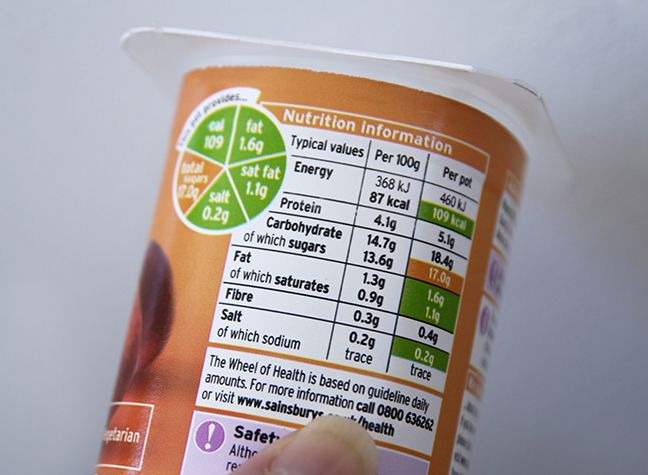



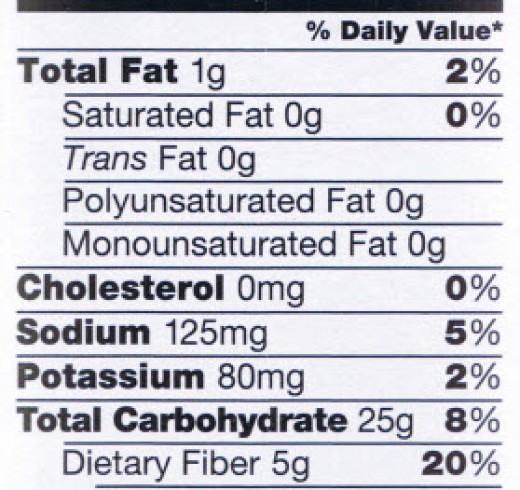
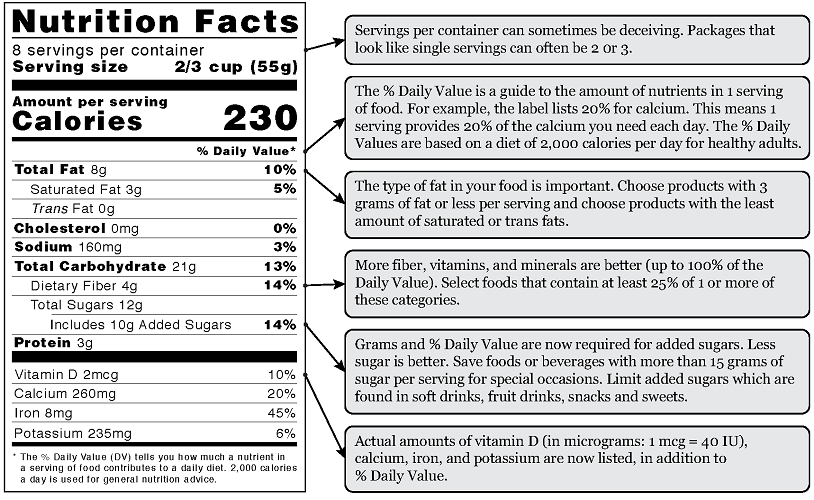
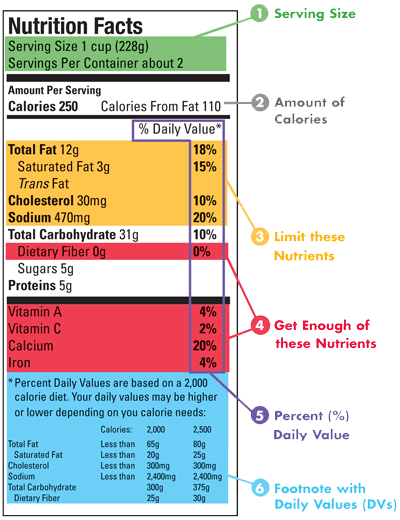


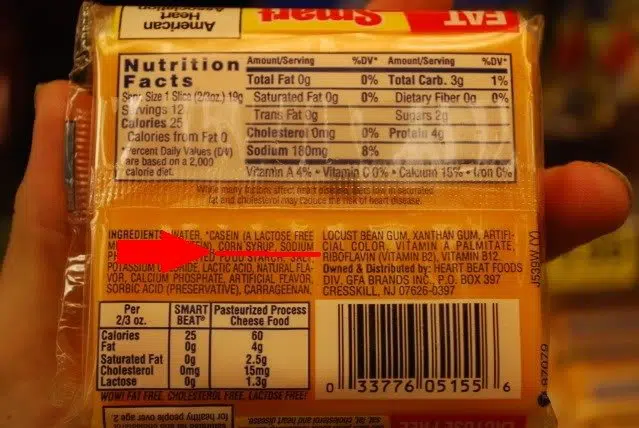
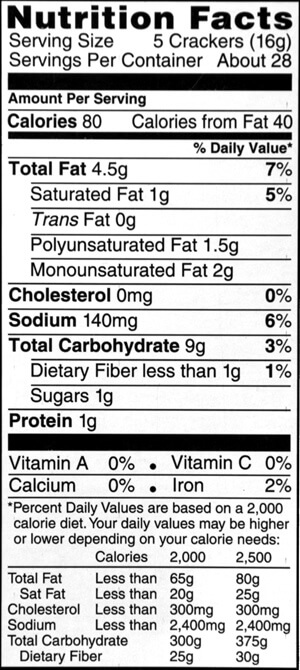
Post a Comment for "43 how to read nutrition labels fat"